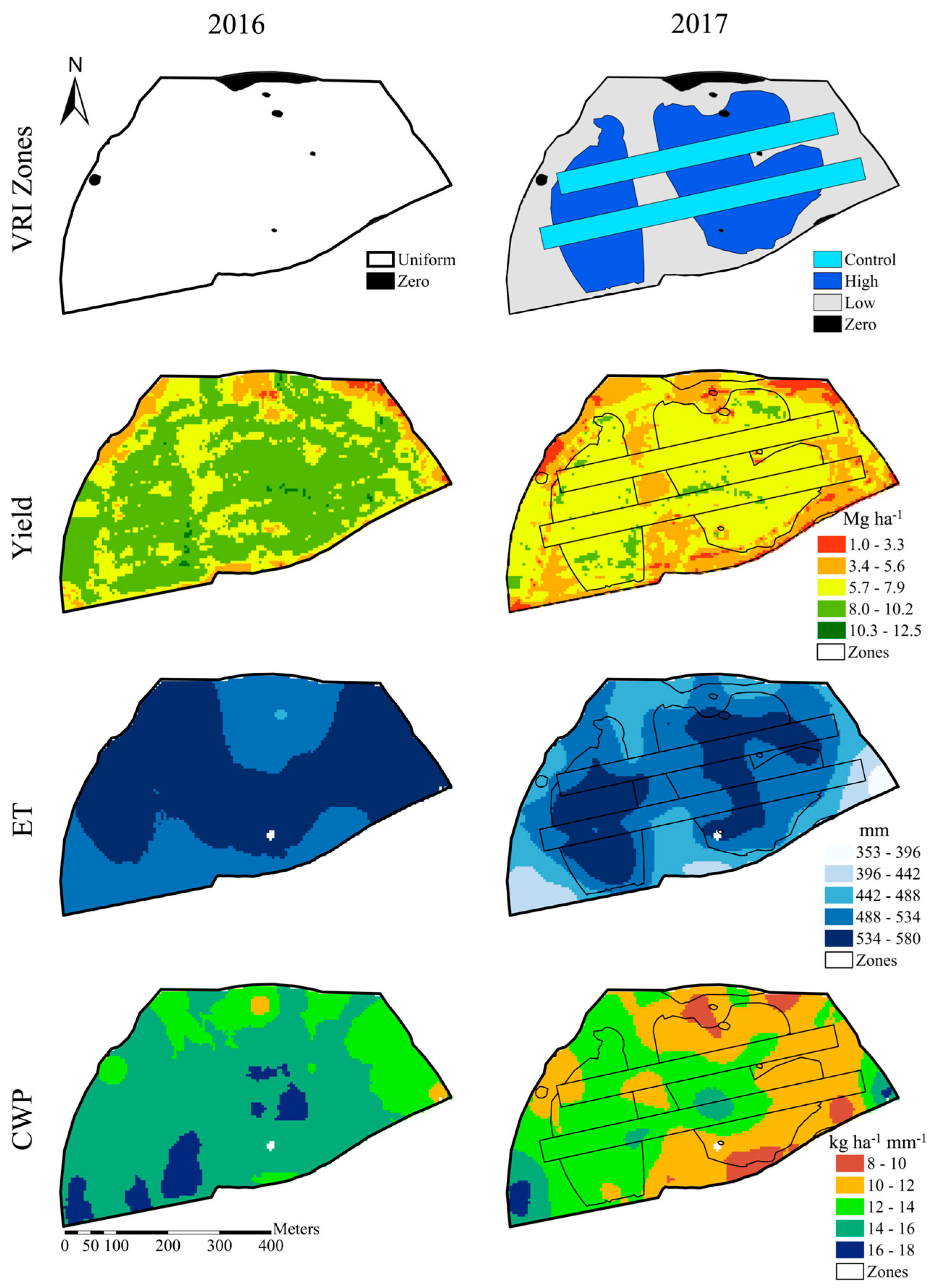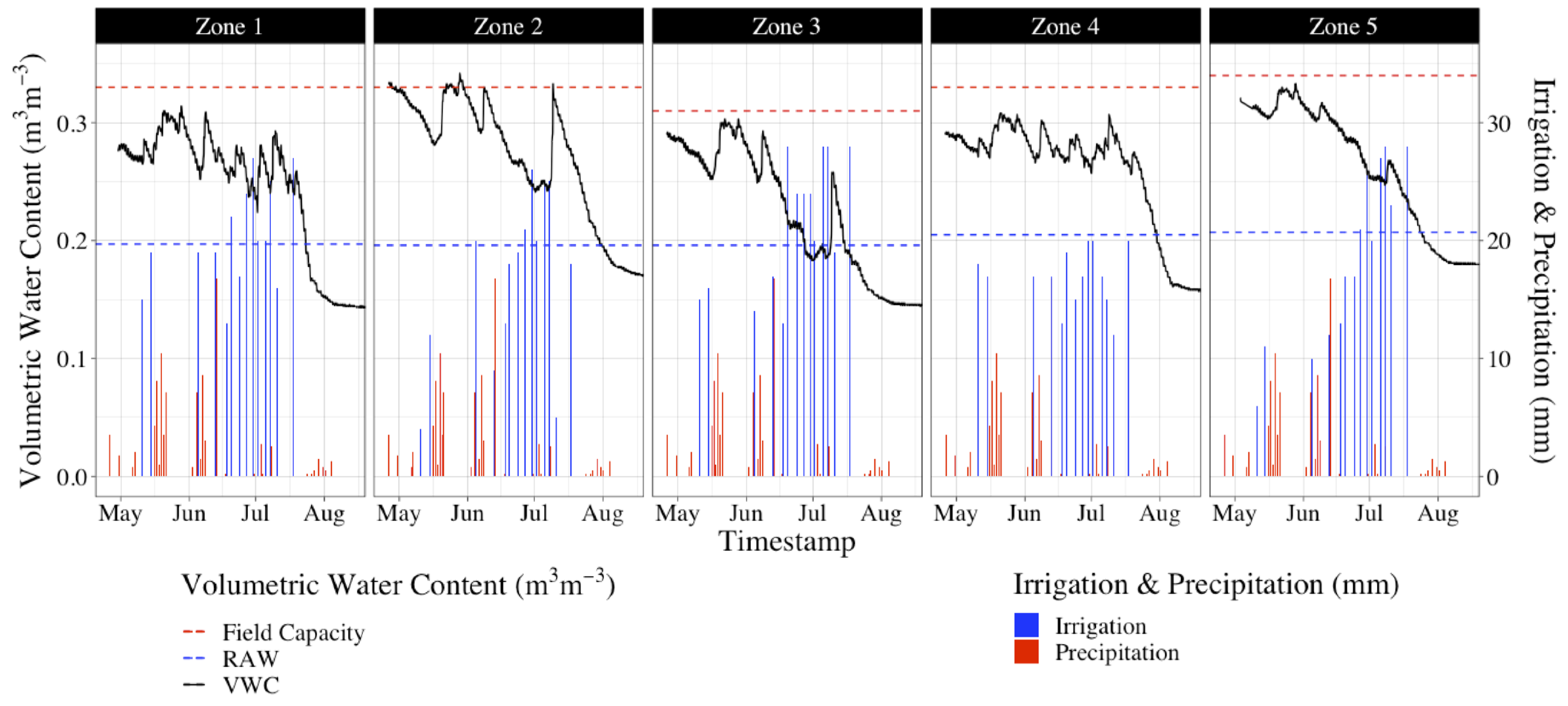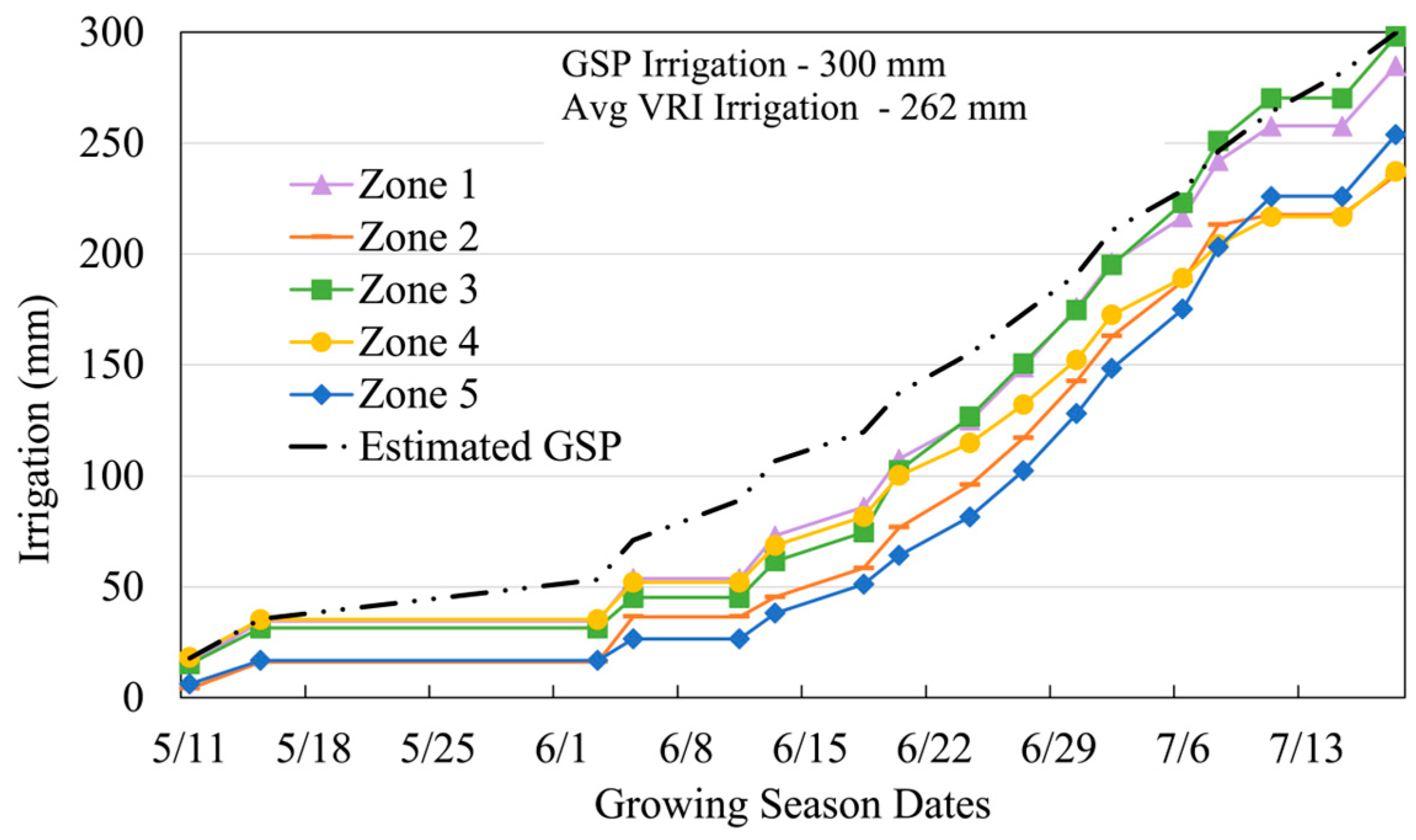Irrigation Zone Delineation and Management with a Field-Scale Variable Rate Irrigation System in Winter Wheat
Abstract
:1. Introduction
1.1. Yield and Crop Water Needs Are Spatially and Temporally Variable
1.2. Delineating and Managing Zones for VRI
2. Materials and Methods
2.1. Study Site
2.2. Soil Volumetric Water Content (VWC)
2.3. Evapotranspiration
2.4. Yield and Crop Water Productivity
2.5. Irrigation Management Zones
2.6. VWC Data Collection through Soil Sensors in 2019
3. Results
3.1. Zone Delineation by Observed CWP
3.2. 2019 Variable Rate Irrigation
4. Discussion
4.1. Zone Delineation
4.2. Cumulative Irrigation Events
4.3. Temporal Differences of VWC
5. Conclusions
Author Contributions
Funding
Data Availability Statement
Acknowledgments
Conflicts of Interest
References
- Zhu, X.; Chikangaise, P.; Shi, W.; Chen, W.H.; Yuan, S. Review of Intelligent Sprinkler Irrigation Technologies for Remote Autonomous System. Int. J. Agric. Biol. Eng. 2018, 11, 23–30. [Google Scholar] [CrossRef]
- Maestrini, B.; Basso, B. Drivers of Within-Field Spatial and Temporal Variability of Crop Yield across the US Midwest. Sci. Rep. 2018, 8, 1–9. [Google Scholar] [CrossRef]
- Svedin, J.D. Characterizing the Spatial Variation of Crop Water Productivity for Variable-Rate Irrigation Management, Brigham Young University, Provo. 2018. Available online: https://scholarsarchive.byu.edu/cgi/viewcontent.cgi?article=7878&context=etd (accessed on 6 December 2022).
- Svedin, J.D.; Hansen, N.C.; Kerry, R.; Hopkins, B.G. Modeling Spatio-Temporal Variations in Crop Water Stress for Variable-Rate Irrigation. In Proceedings of the Precision Agriculture ’19—Papers Presented at the 12th European Conference on Precision Agriculture, Montpellier, France, 8–11 July 2019; Wageningen Academic Publishers: Wageningen, The Netherlands, 2019; pp. 687–693. [Google Scholar] [CrossRef]
- Longchamps, L.; Khosla, R.; Reich, R.; Gui, D.W. Spatial and Temporal Variability of Soil Water Content in Leveled Fields. Soil Sci. Soc. Am. J. 2015, 79, 1446–1454. [Google Scholar] [CrossRef]
- De Lara, A.; Khosla, R.; Longchamps, L. Characterizing Spatial Variability in Soil Water Content for Precision Irrigation Management. Adv. Anim. Biosci. 2017, 8, 418–422. [Google Scholar] [CrossRef]
- Evans, R.G.; King, B.A. Site-Specific Sprinkler Irrigation in a Water-Limited Future. Trans. ASABE 2012, 55, 493–504. [Google Scholar] [CrossRef]
- King, B.A.; Stark, J.C.; Wall, R.W. Comparison of Site-Specific and Conventional Uniform Irrigation Management for Potatoes. Appl. Eng. Agric. 2006, 22, 677–688. [Google Scholar] [CrossRef]
- Haghverdi, A.; Leib, B.G.; Washington-Allen, R.A.; Ayers, P.D.; Buschermohle, M.J. High-Resolution Prediction of Soil Available Water Content within the Crop Root Zone. J. Hydrol. 2015, 530, 167–179. [Google Scholar] [CrossRef]
- Sadler, E.J.; Evans, R.G.; Stone, K.C.; Camp, C.R. Opportunities for Conservation with Precision Irrigation. J. Soil Water Conserv. 2005, 60, 371–378. [Google Scholar]
- O’Shaughnessy, S.A.; Evett, S.R.; Colaizzi, P.D.; Andrade, M.A.; Marek, T.H.; Heeren, D.M.; Lamm, F.R.; LaRue, J.L. Identifying Advantages and Disadvantages of Variable Rate Irrigation: An Updated Review. Appl. Eng. Agric. 2019, 35, 837–852. [Google Scholar] [CrossRef]
- Daccache, A.; Knox, J.W.; Weatherhead, E.K.; Daneshkhah, A.; Hess, T.M. Implementing Precision Irrigation in a Humid Climate—Recent Experiences and on-Going Challenges. Agric. Water Manag. 2015, 147, 135–143. [Google Scholar] [CrossRef]
- Hedley, C.B.; Yule, I.J.; Tuohy, M.P.; Vogeler, I. Key Performance Indicators for Simulated Variable-Rate Irrigation of Variable Soils in Humid Regions. Trans. ASABE 2009, 52, 1575–1584. [Google Scholar] [CrossRef]
- Hedley, C.B.; Yule, I.J. Soil Water Status Mapping and Two Variable-Rate Irrigation Scenarios. Precis. Agric. 2009, 10, 342–355. [Google Scholar] [CrossRef]
- Messick, R.M.; Heaton, M.J.; Hansen, N. Multivariate Spatial Mapping of Soil Water Holding Capacity with Spatially Varying Cross-Correlations. Ann. Appl. Stat. 2017, 11, 69–92. [Google Scholar] [CrossRef]
- Zhao, W.X.; Li, J.; Yang, R.M.; Li, Y.F. Crop Yield and Water Productivity Responses in Management Zones for Variable-Rate Irrigation Based on Available Soil Water Holding Capacity. Trans. ASABE 2017, 60, 1659–1667. [Google Scholar] [CrossRef]
- Haghverdi, A.; Leib, B.G.; Washington-Allen, R.A.; Ayers, P.D.; Buschermohle, M.J. Perspectives on Delineating Management Zones for Variable Rate Irrigation. Comput. Electron. Agric. 2015, 117, 154–167. [Google Scholar] [CrossRef]
- Lo, T.; Heeren, D.M.; Mateos, L.; Luck, J.D.; Martin, D.L.; Miller, K.A.; Barker, J.B.; Shaver, T.M. Field Characterization of Field Capacity and Root Zone Available Water Capacity for Variable Rate Irrigation. Appl. Eng. Agric. 2017, 33, 559–572. [Google Scholar] [CrossRef]
- Huang, X. Analysis of Effects of Soil Properties, Topographical Variables and Management Practices on Spatial-Temporal Variability of Crop Yields. Ph.D. Thesis, Michigan State University, East Lansing, MI, USA, 2008. [Google Scholar] [CrossRef]
- Moore, I.D.; Gessler, P.E.; Nielsen, G.A.; Peterson, G.A. Soil Attribute Prediction Using Terrain Analysis. Soil Sci. Soc. Am. J. 1993, 57, 443–452. [Google Scholar] [CrossRef]
- Maestrini, B.; Basso, B. Predicting Spatial Patterns of Within-Field Crop Yield Variability. Field. Crops. Res. 2018, 219, 106–112. [Google Scholar] [CrossRef]
- Kravchenko, A.N.; Bullock, D.G.; Boast, C.W. Joint Multifractal Analysis of Crop Yield and Terrain Slope. Agron. J. 2000, 92, 1279–1290. [Google Scholar] [CrossRef]
- Evans, R.G.; LaRue, J.; Stone, K.C.; King, B.A. Adoption of Site-Specific Variable Rate Sprinkler Irrigation Systems. Irrig. Sci. 2013, 31, 871–887. [Google Scholar] [CrossRef]
- Jimenez, A.F.; Ortiz, B.V.; Bondesan, L.; Morata, G.; Damianidis, D. Long Short-Term Memory Neural Network for Irrigation Management: A Case Study from Southern Alabama, USA. Precis. Agric. 2021, 22, 475–492. [Google Scholar] [CrossRef]
- Hedley, C.B.; Yule, I.J. A Method for Spatial Prediction of Daily Soil Water Status for Precise Irrigation Scheduling. Agric. Water Manag. 2009, 96, 1737–1745. [Google Scholar] [CrossRef]
- Vories, E.; O’Shaughnessy, S.; Andrade, M. Comparison of Precision and Conventional Irrigation Management of Cotton. In Proceedings of thePrecision Agriculture ’19—Papers Presented at the 12th European Conference on Precision Agriculture, Montpellier, France, 8–11 July 2019; Wageningen Academic Publishers: Wageningen, The Netherlands, 2019; pp. 695–702. [Google Scholar] [CrossRef]
- O’Shaughnessy, S.A.; Evett, S.R.; Colaizzi, P.D.; Howell, T.A. A Crop Water Stress Index and Time Threshold for Automatic Irrigation Scheduling of Grain Sorghum. Agric. Water Manag. 2012, 107, 122–132. [Google Scholar] [CrossRef]
- King, B.A.; Brady, R.A.; McCann, I.R.; Stark, J.C. Variable Rate Water Application through Sprinkler Irrigation. In Site-Specific Management for Agricultural Systems; American Society of Agronomy: Madison, WI, USA, 1995; pp. 485–493. [Google Scholar] [CrossRef]
- Bianchi, A.; Masseroni, D.; Thalheimer, M.; de Medici, L.O.; Facchi, A. Field Irrigation Management through Soil Water Potential Measurements: A Review. Ital. J. Agrometeorol. 2017, 22, 25–38. [Google Scholar] [CrossRef]
- López-Riquelme, J.A.; Pavón-Pulido, N.; Navarro-Hellín, H.; Soto-Valles, F.; Torres-Sánchez, R. A Software Architecture Based on FIWARE Cloud for Precision Agriculture. Agric. Water Manag. 2017, 183, 123–135. [Google Scholar] [CrossRef]
- Smith, R.; Oyler, L.; Campbell, C.; Woolley, E.A.; Hopkins, B.G.; Kerry, R.; Hansen, N.C. A New Approach for Estimating and Delineating Within-Field Crop Water Stress Zones with Satellite Imagery. Int. J. Remote. Sens. 2021, 42, 6005–6024. [Google Scholar] [CrossRef]
- Zhao, W.; Li, J.; Yang, R.; Li, Y. Determining Placement Criteria of Moisture Sensors through Temporal Stability Analysis of Soil Water Contents for a Variable Rate Irrigation System. Precis. Agric. 2018, 19, 648–665. [Google Scholar] [CrossRef]
- AgriMet Columbia-Pacific Northwest Region|Bureau of Reclamation. Available online: https://www.usbr.gov/pn/agrimet/wxdata.html (accessed on 13 March 2023).
- Soil Survey Staff. Web Soil Survey. USDA-NRCS. Available online: https://websoilsurvey.sc.egov.usda.gov/App/WebSoilSurvey.aspx (accessed on 6 December 2022).
- Kerry, R.; Oliver, M.A. Variograms of Ancillary Data to Aid Sampling for Soil Surveys. Precis. Agric. 2003, 4, 261–278. [Google Scholar] [CrossRef]
- Webster, R.; Oliver, M.A. Geostatistics for Environmental Scientists; Wiley: Hoboken, NJ, USA, 2007. [Google Scholar]
- Kerry, R.; Oliver, M.A. Determining Nugget:Sill Ratios of Standardized Variograms from Aerial Photographs to Krige Sparse Soil Data. Precis. Agric. 2008, 9, 33–56. [Google Scholar] [CrossRef]
- Woolley, E.A. Soil Water Dynamics within Variable Rate Irrigation Zones of Winter Wheat. Masters Thesis, Brigham Young University, Provo, UT, USA, 2020. Available online: https://scholarsarchive.byu.edu/etd (accessed on 15 February 2023).
- Allen, R.G.; Pereira, L.S.; Raes, D.; Smith, M. Crop Evapotranspiration—Guidelines for Computing Crop Water Requirements—FAO Irrigation and Drainage Paper 56; Food and Agriculture Organization of the United Nations: Rome, Italy, 1998; Available online: https://www.fao.org/3/x0490e/x0490e00.htm (accessed on 6 December 2022).
- Myers, P.; McIntosh, C.S.; Patterson, P.E.; Taylor, R.G.; Hopkins, B.G. Optimal Crop Rotation of Idaho Potatoes. Am. J. Potato. Res. 2008, 85, 183–197. [Google Scholar] [CrossRef]
- Agricultural Experiment & UI Extension Publications. Irrigated Spring Wheat Production Guide for Southern Idaho. Available online: https://www.lib.uidaho.edu/digital/uiext/items/uiext23590.html (accessed on 5 April 2023).
- Bockus, W.W.; Bowden, R.L.; Hunger, R.M.; Morrill, W.L.; Murray, T.D.; Smiley, R.W. Compendium of Wheat Diseases and Pests, 3rd ed.; The American Phytopathological Society: St. Paul, MN, USA, 2010. [Google Scholar] [CrossRef]
- Hawley, M.E.; Jackson, T.J.; Mccuen, R.H. Surface Soil Moisture Variation on Small Agricultural Watersheds. J. Hydrol. 1983, 62, 179. [Google Scholar] [CrossRef]
- Woolley, E.A.; Kerry, R.; Hansen, N.C.; Hopkins, B.G. Variable Rate Irrigation: Investigating within-Zone Variability. In Precision Agriculture ’21, Proceedings of the 13th European Conference on Precision Agriculture, Budapest, Hungary, 18–22 July 2021; Wageningen Academic Publishers: Wageningen, The Netherlands, 2021; pp. 635–641. [Google Scholar] [CrossRef]
- Kaleita, A.L.; Hirschi, M.C.; Tian, L.F. Field-Scale Surface Soil Moisture Patterns and Their Relationship to Topographic Indices. Trans. ASABE 2007, 50, 557–564. [Google Scholar] [CrossRef]
- Baroni, G.; Ortuani, B.; Facchi, A.; Gandolfi, C. The Role of Vegetation and Soil Properties on the Spatio-Temporal Variability of the Surface Soil Moisture in a Maize-Cropped Field. J. Hydrol. 2013, 489, 148–159. [Google Scholar] [CrossRef]




| Date | Zone 1 | Zone 2 | Zone 3 | Zone 4 | Zone 5 | GSP Est |
|---|---|---|---|---|---|---|
| mm | ||||||
| 5/11 | 15 | 4 | 15 | 18 | 6 | 18 |
| 5/15 | 19 | 12 | 16 | 17 | 11 | 18 |
| 6/3 | 0 | 0 | 0 | 0 | 0 | 18 |
| 6/5 | 19 | 20 | 14 | 17 | 10 | 18 |
| 6/11 | 0 | 0 | 0 | 0 | 0 | 18 |
| 6/13 | 19 | 9 | 17 | 17 | 12 | 18 |
| 6/18 | 13 | 13 | 13 | 13 | 13 | 13 |
| 6/20 | 22 | 18 | 28 | 19 | 13 | 18 |
| 6/24 | 17 | 19 | 24 | 15 | 17 | 18 |
| 6/27 | 24 | 21 | 24 | 17 | 21 | 18 |
| 6/30 | 27 | 26 | 24 | 20 | 26 | 18 |
| 7/2 | 20 | 20 | 20 | 20 | 20 | 20 |
| 7/6 | 20 | 25 | 28 | 17 | 27 | 18 |
| 7/8 | 25 | 25 | 28 | 15 | 28 | 18 |
| 7/11 | 16 | 5 | 19 | 12 | 23 | 18 |
| 7/15 | 0 | 0 | 0 | 0 | 0 | 18 |
| 7/18 | 27 | 18 | 28 | 20 | 28 | 18 |
| Total | 285 | 236 | 298 | 237 | 254 | 300 |
Disclaimer/Publisher’s Note: The statements, opinions and data contained in all publications are solely those of the individual author(s) and contributor(s) and not of MDPI and/or the editor(s). MDPI and/or the editor(s) disclaim responsibility for any injury to people or property resulting from any ideas, methods, instructions or products referred to in the content. |
© 2023 by the authors. Licensee MDPI, Basel, Switzerland. This article is an open access article distributed under the terms and conditions of the Creative Commons Attribution (CC BY) license (https://creativecommons.org/licenses/by/4.0/).
Share and Cite
Flint, E.A.; Hopkins, B.G.; Svedin, J.D.; Kerry, R.; Heaton, M.J.; Jensen, R.R.; Campbell, C.S.; Yost, M.A.; Hansen, N.C. Irrigation Zone Delineation and Management with a Field-Scale Variable Rate Irrigation System in Winter Wheat. Agronomy 2023, 13, 1125. https://doi.org/10.3390/agronomy13041125
Flint EA, Hopkins BG, Svedin JD, Kerry R, Heaton MJ, Jensen RR, Campbell CS, Yost MA, Hansen NC. Irrigation Zone Delineation and Management with a Field-Scale Variable Rate Irrigation System in Winter Wheat. Agronomy. 2023; 13(4):1125. https://doi.org/10.3390/agronomy13041125
Chicago/Turabian StyleFlint, Elisa A., Bryan G. Hopkins, Jeffery D. Svedin, Ruth Kerry, Matthew J. Heaton, Ryan R. Jensen, Colin S. Campbell, Matt A. Yost, and Neil C. Hansen. 2023. "Irrigation Zone Delineation and Management with a Field-Scale Variable Rate Irrigation System in Winter Wheat" Agronomy 13, no. 4: 1125. https://doi.org/10.3390/agronomy13041125





